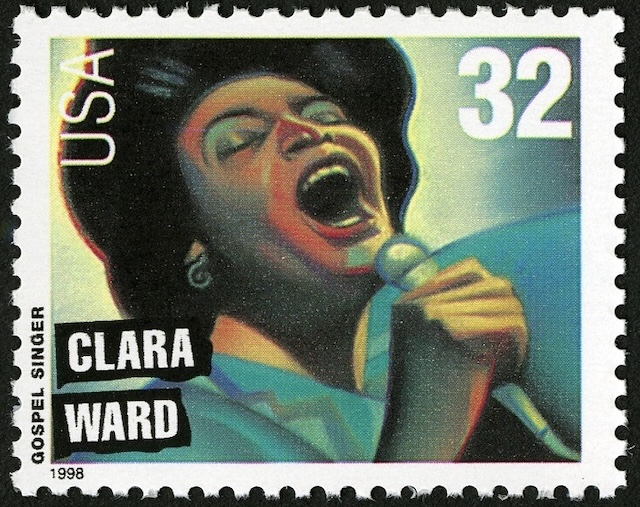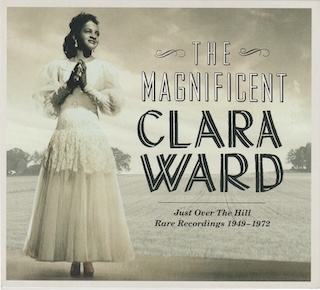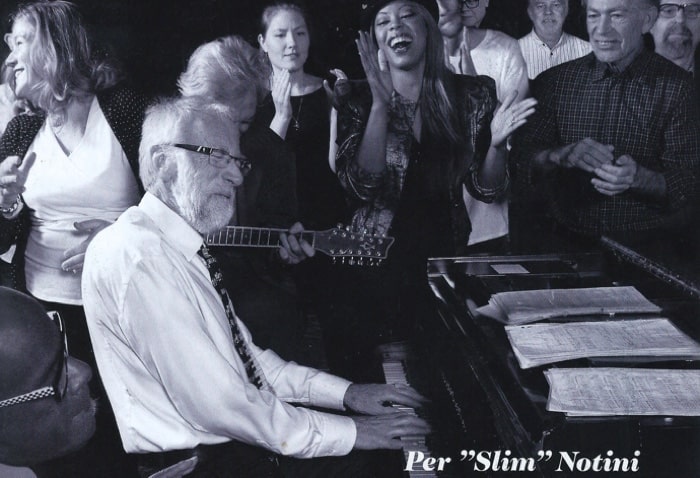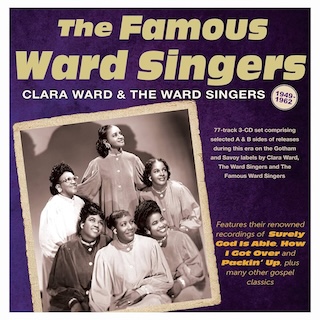
Clara Ward was honored by the U.S. Postal Service in a series of four 32-cent Gospel Singers commemorative stamps (part of Postal Service’s Legends of American Music Series) issued on July 15, 1998. Also honored: Mahalia Jackson, Roberta Martin, and Sister Rosetta Tharpe. The stamped were designed by Howard Paine of Delaplane, Virginia, and illustrated by Gary Kelley of Cedar Falls, Iowa.
By David McGee
 THE MAGNIFICENT CLARA WARD: JUST OVER THE HILL 1949-1972
THE MAGNIFICENT CLARA WARD: JUST OVER THE HILL 1949-1972
Clara Ward
Gospel Friend
If we break down Clara Ward’s monumental, influential career strictly to the music, then this welcome trove of rare and previously unissued (some thought lost) recordings spanning Ward’s entire studio output offers an invaluable overview chronicling the magnitude of Clara’s artistry and of her accompanying Ward Singers’ deeply commanding support (one of those singers, Marion Williams, became a gospel giant in her own right after leaving Clara’s employment and establishing one of gospel music’s most important careers during which she was favorably compared to Mahalia Jackson)—a blend so fervent and fiery as to leave a listener both shaken and uplifted, as the greatest gospel music will do.

‘Old Landmark,’ the Clara Ward Singers, from a concert filmed in France, 1962
This is the latest release from Swedish producer Per “Stockholm Slim” Notini’s Gospel Friend label. Heretofore Notini has issued important compilations of Bobby Robinson’s Revelation Records label (in 2005’s Best of Revelation Records, 1959-1962); of Edna Gallmon Cooke (2017’s My Joy: Rare Recordings, 1946-1966); of the Pilgrim Travelers (2015’s Gospel Boogie: Rare Recordings, 1946-1957); and 2018’s Soul Don’t Worry! Black Gospel During the Civil Rights Era, 1953-1967 (the latter on the NarroWay label). A musician as well as a producer and gospel collector, Notini leads his own choir and gospel group, Slim’s Gospel Train, and also steps outside the gospel lines just a bit with his blues group, Slim’s Blues Gang. In his liner notes for the Ward compilation, Notini says the song program here “has been set up to avoid duplication on any other CD released on the Wards during the last 23 years.” He’s also made extensive use of various credible sources of biographical background in his summary of her and her Singers’ productive career, including what he describes as Clara’s “manifesto,” in her own words, to wit:
A gospel singer cannot be successful without living and breathing every word he or she sings. Just like friends, Gospel songs cheer folks when they are downhearted, and they give hope people hope to continue their daily lives even when times look bleak. They can bring sweet and wonderful messages to the lonely and sick.
Perhaps this explains how we cannot turn our backs on requests from the audience. You never know how much it might mean to the requester. It is, by no means, an easy life, but it is impossible to resist the joy of bringing happiness to people…
That hint of melancholy—…it is no easy life…–was a declaration both personal and professional, which were tragically intertwined in Clara’s life, since her and the group’s career was steered by her domineering, cruelly parsimonious mother, Gertrude Ward, who was both group founder and hard driving manager who shares with the “woefully under-recorded” (as gospel authority Anthony Heilbut notes in his essential The Gospel Sound) Marion Johnson Davis a dual honor in being both a performer and an early pioneer of all-female gospel groups. On the one hand, it was Gertrude’s vision that put she, Clara, her oldest daughter Willa and all the other Ward Singers in flashy stage outfits, in Cadillacs from gig to gig, and into embracing flamboyant stage theatrics more common to pop productions. She also booked the group members into fleabag hotels and apparently had no conscience when it came to underpaying her charges, or not paying them at all, with the result being a revolving door of Ward Singers over the years as the likes of Marion Williams bailed out, leaving Gertrude, Clara and Willa as the mainstays into the ‘60s as they were in the ‘40s.

‘From Youth to Old Age,’ Clara Ward’s autobiographical original, from her final sessions. Recorded for Nashboro Records, 1971, and featured on The Magnificent Clara Ward
This is all backstory, and only a part of it. What we have in this latest contribution from Gospel Friend are 27 splendid, moving examples of the force of nature that was Clara Ward. The first three cuts alone are riveting: John Travis’s “Tired” and W.H. Brewster’s evergreen “Just Over the Hill” (both from 1949) feature Clara solo backed only by piano and organ, the aching purity and versatility of the Ward soprano on full display, especially on the latter hymn, when she dips for effect into a lower register before rising to a keening, heartfelt cry again; and the Famous Ward Singers’ first appearance on the disc comes in a muscular workout on Clara’s “Prince of Peace,” wherein the full force of the Wards’ approach hits like a gale wind in its urgency and drive, with Clara soaring over it all in triumphant, assured salvation fervor. On the fifth cut, “Salvation is Free,” an old warhorse even in 1951, having originated in the late 19th-early 20th century, its author in dispute (Harriet Jones? A.M. Brunner?), we hear Clara solo again, backed only by organ and a most discrete piano, making a statement as personal as any she would ever record, her vocal so measured and deeply soulful she claims the lyrics as her own testimony. It’s as if the disappointments and hardships she would reference in her comment about gospel’s hard life were raining in her heart, informing every wrenching, drawn-out phrase, every guttural moan, every clipped word, every wounded upper register sortie (“Yes, I’m a pilgrim, a pilgrim without a home…”), until, at the end, adopting a tender, brassy tone, she offers a vocal exhale of gratitude, but one heavily dripping in irony, singing “…and I’m so glad…saaalva…shun’s free.”

‘Salvation is Free,’ Clara Ward, solo with organ and piano, as heard on The Magnificent Clara Ward
Amazingly, the final recordings from 1967 to 1971 (all solo) for Nashboro Records, produced by Shannon Williams, with hymns selected by gospel authority Anthony Heilbut, find the Ward voice every bit as pliable and expressive as the young volcanic artist who wrung every ounce of truth from her pleas for salvation, mercy, and redemption in 1949 gems such as “Tired” and Roberta Martin’s “I’ve Got a Home”; indeed, the older, and sickly (she had barely recovered from a stroke when the sessions began), Clara soars, soul free, in triumphant expectations of eternal life in her autobiographical reflection “From Youth to Old Age” and in the early 20th Century church hymn “Last Mile of the Way,” with only a ruminative organ, spare piano and subtle drums unobtrusively serving moments of heightened emotional outpouring.
In The Gospel Sound, Anthony Heilbut, who witnessed the Nashboro sessions, offers a striking portrait of the artist at work:
“Seated at the piano, eyes stabbed shut, chin jutting out for ballast for all that nasal fervor, she sang three hymns, ‘Beams of Heaven,’ ‘The Name Jesus,’ and ‘The Last Mile of the Way.’ They were certainly her deepest recordings since 1958 when Marion Williams and the others had quit her. And now, without even Gertrude Ward around to build the fire, Clara seemed to be absolutely serious, fully on her own. At the end of the last song, she sang ‘When I’ve gone,’ paused to laugh, then ended, ‘the last mile of the way.’ The holy laugh is fresh from that diaphragmatic root where moans originate. It’s the lustiest chuckle I’ve heard and Clara’s finest individual sound in years. Afterward she apologized to Shannon Williams, ‘I don’t know what made me do that. God knows, I haven’t enjoyed a record session like this in years.’”

‘The Last Mile of the Way,’ Clara Ward, from her final sessions, 1971, released by Nashboro Records, produced by Shannon Williams, as featured on The Magnificent Clara Ward. Note the ‘holy laugh’ Anthony Halibut describes in The Gospel Sound at approximately 2:38.
A month following the completion of the 1971 Nashboro sessions, Clara suffered her second, and fatal, stroke, laid in a coma for a month, then passed away on January 16, 1973.
Living and breathing every word she sings on these 27 tracks, Clara Ward abides.
***

Producer Per Notini on Clara Ward: A Quick Q&A
Who is Per Notini? The Swedish publication Jefferson Blues offers an in-depth profile of one of the country’s foremost practitioners of blues and gospel. Written by Birgitta Larsson and published on September 13, 2015, it begins:
When Per, at the age of 21, got to play piano on Magic Sam’s album West Side Soul, he had no idea that it would become a real cult record: one of the most famous recordings in Chicago blues history! Stockholm Slim was his name on the album, and this is probably the most internationally famous thing a Swedish blues artist has ever achieved.
The year was 1967. An early gold star in Slim’s CV. The road since then has been varied. For a long time, the blues was all that dominated him–the LP Blues På Svenska: Peps Och Slim, released in 1975, among other things, attracted attention–but from the early nineties, gospel changed his direction radically. He has now made a name for himself as one of the foremost gospel performers in our country–as a pianist, ensemble leader, singer, arranger and producer. However, the blues has not been completely abandoned: we can see him in the trio Bill, Slim & Guy–a blues band he was part of starting back in 1962 under the name Slim’s Blues Gang. To my knowledge, it is Sweden’s first blues band. Also the oldest, still going strong! Slim is–along with Peps Persson and Bill Öhrström–a true pioneer in Swedish blues.
We have known Per for a long time as “Slim” Notini. How did he get the name Slim? Well, it was the pianist Lasse Edegran, who thought he recognized certain piano licks, which a young Per planked from Memphis Slim.
Deep Roots reached out to Per to fill in some background on the making of The Magnificent Clara Ward.

‘A City Called Heaven,’ Clara Ward Singers on The Ed Sullivan Show, July 27, 1969
You’re no stranger to the world of reissuing vintage recordings by Black American artists in blues, folk and gospel fields. I first heard of you back in 2005 when you issued an essential overview of Bobby Robinson’s Revelation Records label (Best of Revelation Records, 1959-1962). The last I heard from you was 2018’s vital Soul Don’t Worry! Black Gospel During the Civil Rights Era, 1953-1967 on the NarroWay label. I know you’ve also been part of a 1976 reissue release of Floyd Dixon recordings issued with two of your friends on the Route 66 Records label and titled Opportunity Blues. Your illustrious track record now includes a 27-track Clara Ward retrospective, accurately titled The Magnificent Clara Ward: Just Over the Hill—Rare Recordings 1949-1972. How long was this sweeping project in the making?
Per Notini (PN): After having collected blues and rhythm & blues records for three decades, I switched to collecting black gospel records in the mid.1990s. The first records I bought were by Sister Rosetta Tharpe, The Sensational Nightingales, Bro. Cleophus Robinson, Cora & Sallie Martin, The Selah Jubilee Singers, Mahalia Jackson, Sister Ethel Davenport, The Soul Stirrers, The Gospel Harmonettes, The Pilgrim Travelers et al.
Little by little I also became exposed to 78s, 45s, and LPs by The Famous Ward Singers. I was absorbed by Clara Ward’s driving and soulful delivery. To this day, I have assembled the majority of her output–more than 30 LPs and more than 30 singles. To answer your question: It is difficult to pin down the exact time frame for The Magnificent Clara Ward project. With my vast collection already at hand, I would say that it took me between one and two years from the moment I decided to go ahead with the production.
In your liner notes you point out that the selections here are not duplicated on any other Clara Ward release of the past 23 years. How much material did you pore over to arrive at the final 27 tracks?
PN: The References list at the back of the CD booklet should give you an idea of the extent of material I have consulted. Then there are the photos, which I have picked out from the great quantity of available ones. The one in the middle of the booklet, showing Clara Ward in the recording studio, I had to pay to use.
The albums Clara made for Nashboro near the end of her life arguably constitute her least-known recordings but those sessions also brought her back firmly into the gospel fold after a detour into the mainstream, during which time she recorded popular some popular pop ballads of the day and adopted more theatrical garb and presentations that alienated her core gospel fans The selections you include on your disc happen to be some of her most powerful, and personal, performances: “From Youth to Old Age,” “The Last Mile of the Way,” and “Set Me Free” certainly leave no doubt as to the primacy of gospel in life and art.
Yes, Clara Ward’s Nashboro recordings are her least known ones. I agree that they belong to her strongest and most moving performances on records. The piece “From Youth To Old Age” was erroneously noted as Clara’s composition. Anthony Heilbut informed me that the song was written in 1901 by the progenitor of black gospel, Charles Albert Tindley.
You’ve also clarified gospel authority Anthony Heilbut’s role in those Nashboro sessions—he not only wrote liner notes but chose the hymns for Clara. Various sources report her working relationship with producer Shannon Williams was very strong. What’s your take on Shannon Williams’s contribution to Clara’s Nashboro legacy?
PN: Shannon Williams was certainly dedicated to documenting black gospel. It is true that Clara was satisfied with the results from producer Shannon Williams’ recordings at Nashboro. But it was Anthony Heilbut who chose some of the greatest songs for her to sing. The pianist at this occasion was probably Charles May, the son of the famous Brother Joe May.
One of the amazing aspects of this overview is the strength and vitality of Clara’s voice over the decades—despite being in failing health at the time she signed with Nashboro, her mature vocals impress me as being every bit as vital and commanding as they are on the performances from the ‘40s, ‘50s and ‘60s. You don’t have to do an A/B test with the earlier and later albums to confirm how well her voice stood the test of time. Are there any particular cuts that really hit you where you live? That take you to that place in the heart and the soul where the effect of her performance(s) passes all understanding?
PN: Of the early ’50s recordings “I’m Holding On” is the one that I cherish and adore more than other pieces. Perhaps contributing to this choice is the doubling of the tempo, after ca 1.40 min. Here she goes into the final bars with accelerating stamina. Of the early/mid 1960s pieces, I am especially moved by her rendition of the hymn “Canaan”. She displays her firm hope to be received in Heaven with a blessing “…for the work I’ve done below.” Finally, there is the beautiful “Last Mile of the Way,” sung with conviction and jubilant power. Notice how she bursts out in a “holy laugh” at the very end of this performance.
Further Listening:
 THE FAMOUS WARD SINGERS, Clara Ward & The Ward Singers (Acrobat, 2023)—A three-CD, 77-track collection of most of the 130-plus sides the group released on the Savoy and Gotham labels between 1948 and 1961, billed variously as Clara Ward (solo), Clara Ward Specials, Clara Ward & Ward Singers, Gertrude Ward And Daughters, Famous Ward Singers, and The Ward Singers. The 23-page liner booklet includes complete (and invaluable) sessionography and a sharp 11-page biographical essay by Paul Watts, who notes, “(This) does not purport to be any kind of complete or definitive anthology, but we trust it offers a reasonably substantial and representative overview of what was probably the key period of their career, and we hope that it presents an inspiring and uplifting showcase for their distinctive approach to gospel.” It may not be complete or definitive, but The Famous Ward Singers is certainly essential. –DM
THE FAMOUS WARD SINGERS, Clara Ward & The Ward Singers (Acrobat, 2023)—A three-CD, 77-track collection of most of the 130-plus sides the group released on the Savoy and Gotham labels between 1948 and 1961, billed variously as Clara Ward (solo), Clara Ward Specials, Clara Ward & Ward Singers, Gertrude Ward And Daughters, Famous Ward Singers, and The Ward Singers. The 23-page liner booklet includes complete (and invaluable) sessionography and a sharp 11-page biographical essay by Paul Watts, who notes, “(This) does not purport to be any kind of complete or definitive anthology, but we trust it offers a reasonably substantial and representative overview of what was probably the key period of their career, and we hope that it presents an inspiring and uplifting showcase for their distinctive approach to gospel.” It may not be complete or definitive, but The Famous Ward Singers is certainly essential. –DM


